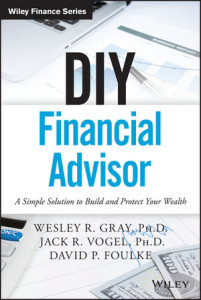 It’s probably bad form of me to slander my own profession, but sometimes it is roundly deserved. So today, I’m going to share some of the insights of Wesley Gray, Jack Vogel and David Foulke in their 2015 book DIY Financial Advisor.
It’s probably bad form of me to slander my own profession, but sometimes it is roundly deserved. So today, I’m going to share some of the insights of Wesley Gray, Jack Vogel and David Foulke in their 2015 book DIY Financial Advisor.
“DIY” stands for do it yourself, of course. And that’s what Gray and his colleagues aim to do. The book shows how retail investors can replace an expensive financial advisor – who may very well be underperforming the market and offering nothing in the way of financial advice that you can’t get elsewhere for far cheaper – with simple, repeatable investment systems.
While a good advisor is still worth every penny you pay them, Gray and his colleagues make some solid observations on why an advisor is often incentivized to give truly terrible advice:
- They focus on short-term rather than long-term results. All too often, investors tend to ask their advisors “What have you done for me lately.” All strategies have their down years, yet having a single underperforming year can get a manager fired. As investors, we tend to chase whatever is hot and drop whatever has recently underperformed. For this reason, a lot of professional managers feel pressure to become closet indexers, which negates their expertise.
- The exploit their authority to generate business. Often, a manager will rely on their credentials to demand a higher fee than their service really deserves. Again, many managers are just closet indexers. There is no reason to pay a man in a suit a fat fee to do what you could do on your own for almost free.
- They prefer complexity over simplicity. Complex models look impressive and help a manager justify a higher fee. But does added complexity actually make a model better? Generally, no. As Gray and his colleagues show, simple models often outperform more complex models and cost a lot less to implement.
Some of this may sound familiar to you. I reviewed Dr. Gray’s previous book, Quantitative Value, which was a case study in a simple but profitable model.
So, if you’re ready to fire your financial advisor, how do you go about it? Gray, Vogel and Foulke offer a step-by-step checklist.
Step one is to evaluate your current relationships. Does your advisor truly add value in any meaningful way, or are you paying them to do something you could do better yourself?
Step two drills down to the “FACTS”:
- Fees
- Access
- Complexity
- Taxes
- Search
On the subject of fees, you have to ask several penetrating questions. First, what are the fees (is it transparent and straight forward?) and secondly, who is paying the advisor? Digging further into the details, is the advisor’s judgment clouded by his relationship with a fund company, or is he being incentivized by a high sales load?
Access really comes into play when looking at hedge funds and private limited partnerships. Gray and his colleagues suggest avoiding these where possible and opting for more liquid arrangement such as separately managed accounts. I agree in principle but would point out that the key words here are “where possible.” Certain strategies (such as real estate development) just don’t work particularly well in a managed account structure.
On the complexity front, keep your investments as simple as possible. The more complex a strategy is, the more likely it is to blow up under financial stress.
Taxes are a critical part of your return. It does you no good if your advisor generates 5% in alpha… only to lose 10% in extra tax costs.
Search costs are also a factor. Alternative managers might very well add value to your portfolio… but searching for them can be time consuming and expensive. And once you’ve found them, monitoring them can be a challenge, since they tend to be less highly regulated.
Once you’ve established your FACTS, you have to understand portfolio management. Gray, Vogel and Foulke break this down into three steps:
- Asset allocation: The authors devote an entire chapter to asset allocation, and it’s much too comprehensive to try and summarize here. But in a nut shell, before you start trying to pick stocks or individual investments, you need to have an idea of what percentage of your portfolio you want allocated to the major asset classes.
- Risk management: Again, volumes have been written on this subject, and the authors dedicate an entire chapter to it. Suffice it to say, you need to protect against large drawdowns, whether you do this with stop losses, simple moving averages or something more complex.
- Security allocation: This is where Gray and his colleagues really shine. They go through some of their favorite value and momentum screens and offer a nice framework for further research.
The advice in DIY Financial Advisor is not for everyone. But it’s certainly recommended reading for anyone considering letting their advisor go. And even if you’re more comfortable hiring a professional, DIY will give you a nice set of criteria to grade your advisor to see if they are worth what you are paying them.
Charles Sizemore is the principal of Sizemore Capital, a wealth management firm in Dallas, Texas.
